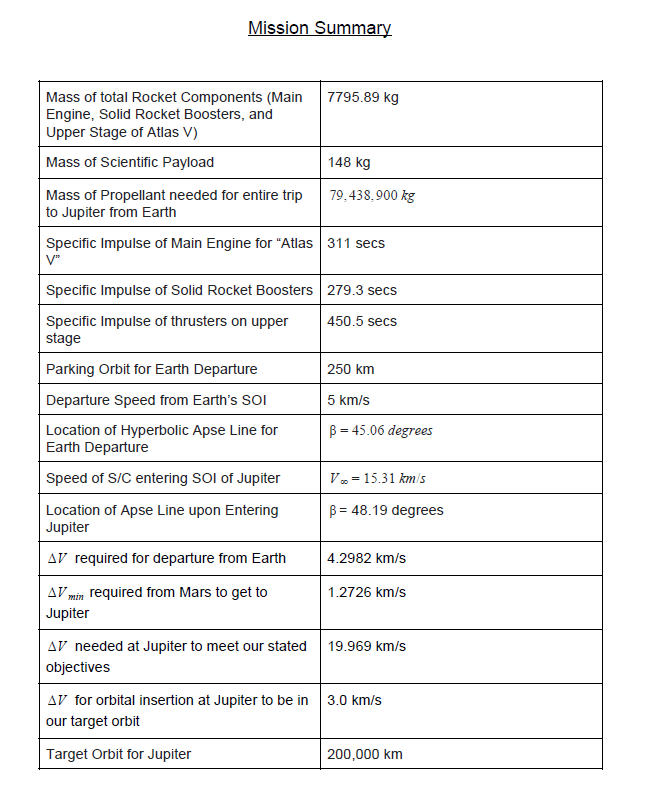SKILLS REQUIRED
MatLab
Orbital Mechanics
Rocketry
Mission Planning
Propulsion Analysis
SUMMARY: Planned Mission to Jupiter using planetary assists, chemical propulsion, and electric propulsion
Physically studying Jupiter again is a key goal for many in the science and engineering communities
DESCRIPTION:
The objective of the project was to create a mission that can send a multistage rocket to Jupiter. The rocket and mission requirements were based on the Atlas V rocket, which launched payloads such as the Mars Reconnaissance Orbiter to Mars, the New Horizons Probe to Pluto and beyond, and many others missions. The purpose of the project was to have students begin to understand and create multi-stage missions that can be performed in actual outer space. In other words, to be able to create a mission that can send payloads to other worlds.
The mission can be summarized into 5 different segments:
Starting at Earth and leaving
Interplanetary travel to Mars
Slingshotting around Mars
Interplanetary travel to Jupiter
Final arrival orbit around Jupiter
One of the most important challenges was updating the equations for each necessary frame of references. For example, at the beginning when starting from Earth, the frame of reference is Earth itself since that’s the most massive object in the area. However, after the vehicle gets past a certain distance from Earth (called the Earth’s “Sphere of Influence” or “Hill Sphere”), the Sun becomes the main reference frame because it has the largest gravity well at that distance. A similar reference frame switch occurs when the payload approaches Mars (and later Jupiter). Learning when to switch between reference frames was important because even if your initial set equations is correct yet you choose a wrong/unwise reference frame, corrections need to be made to the standard equations to account for the unwieldy reference frame - and those corrections tend to be quite messy and greatly increase your chance of making a mistake
Another important lesson learned from this project is that it is not enough (with modern technology) to have a chemical rocket burn the whole time between two distant astral bodies because the necessary fuel would be prohibitively large. Instead, you can only fire your chemical rockets at certain advantageous locations to change your orbit, with the most efficient method called a “Hohmann Transfer'' and was used in this project. For reference: a Hohmann Transfer is a maneuver where you fire your chemical rockets such that they produce a change in overall velocity (called a “ΔV”) ONLY at locations of Maximum Potential Energy (called “Perigees”). When fired at this particular point, you obtain the most efficient fuel burn from your rockets as well as the most efficient usage of the first planet’s gravity well.
Hohmann Transfers are an integral part of getting spacecraft to different planets
The final note from a propulsion/orbital mechanics standpoint is this project was focused on ΔV’s achieved only through the use of chemical processes (combustion) using high thrust engines in addition to gravity wells to get to Jupiter. This is a HIGHLY inefficient setup as 99.99% of the total weight would need to be fuel because you’re firing at VERY specific points in the voyage. Realistically, a system of propulsion called “Electric Propulsion” is employed because the thruster is converting Electrical Potential Energy to Kinetic Energy - a very efficient process. Electric Propulsion is favored for longer missions (such as to Jupiter) because they can provide a very tiny thrust the WHOLE time (vs. high thrust only at specific points on the voyage). The tiny but constant thrust results in higher overall velocity which enables shorter travel times.
Please see the attached files for additional information on the project






